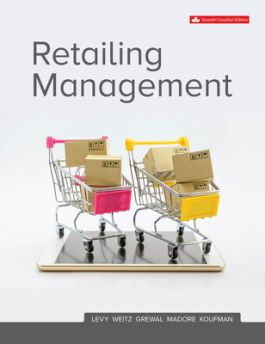Retailing Management
1. Introduction to the World of Retailing
2. Types of Retailers
3. Customer Buying Behaviour
Section 2 Retailing Strategy
4. Retail Market Strategy
5. Retail Locations Strategy-Trade Area Decisions and Site Assessment
6. Store Design, Layout, and Visual Merchandising Strategy
7. International Retailing Strategy
Section 3 Financial Management
8. Financial Strategy
9. Information Systems and Supply Chain Management
10. Buying Strategies
11. Retail Pricing
Section 4 Store Management
12. Human Resource Management and Staff Training Issues
13. Building Customer Loyalty: Customer Relationship Management and Service Strategies
14. Appealing to the Customer: Retail Communication Mix
15. NEW Digital Retailing
Section 5 Cases
The Seventh Canadian edition of Levy is available in Connect. Connect is an award-winning digital teaching and learning solution designed to enhance your teaching style. It allows you to deliver, personalize and measure your course with ease. A Looseleaf print text is available for students to purchase via Connect.
New And Revised End-of-chapter Material. Numerous exercises, problems, and cases have been updated, revised, or replaced with new material to enhance students’ understanding and application of key topics in selling.
New And Updated Cases: The majority of the cases covered in Spotlight on Retailing and Retailing Views are either new or revised, along with the discussion questions newly added to each Retailing Views to further engage students with said topics. Also, four end-of-text cases and accompanying questions were added to this edition.
NEW And Updated APPLICATION-BASED-ACTIVITIES: The Connect Application-Based Activities are highly interactive and automatically graded application- and analysis-based exercises wherein students immerse themselves in a business environment, analyze the situation, and apply their knowledge of business strategies. Students progress from understanding basic concepts to assessing and solving complex, real-world scenarios.
Canadian Perspective. Retailing Management provides examples, cases, and data from the Canadian business environment that help students relate to retailing management issues.
Broad Spectrum of Retailing. Retailing Management focuses on the broad spectrum of Canadian and international retailers, both large and small, that sell merchandise or services. In addition to products in stores, Levy examines the issues facing service retailers, such as Starbucks and non-store retailers like eBay, and Land's End.
Strategic Perspective. Organized around a model of strategic decision making, Levy focuses on critical decisions such as selecting target markets, developing a sustainable competitive advantage, and building an organizational structure and information. It also focuses on distribution systems to support the strategic direction, building customer loyalty, and managing customer relationships.
Operations and Store Management. Traditionally, retailers have exalted merchant royalty-buyers who knew what the hot trends were going to be. By devoting an entire chapter to information systems and supply chain management and an entire section to store management (Chapter 9), Levy reflects the changes that have occurred over the past fifteen years-the shift in emphasis from merchandise management to the block and tackling of getting merchandise to the stores and customers and providing excellent customer services and an exciting shopping experience. Due to this shift toward store management, most students embarking on retail careers now go into store management rather than merchandise buying.
Balanced Approach. Retailing Management offers a balanced approach to teaching an introductory retailing course by including descriptive, how-to, and conceptual information in a highly readable format.
Descriptive Information. Students can learn about the vocabulary and practice of retailing from the descriptive information provided throughout the text.
How-to Information. Retailing Management goes beyond descriptive information to illustrate how and why retailers, large and small, make decisions.
Conceptual Information. Retailing Management includes conceptual information that enables students to understand why decisions are made as outlined in the text. Students need to know these basic concepts so that they can make effective decisions in new situations.
Writing Assignment. The Writing Assignment tool delivers a learning experience to help students improve their written communication skills and conceptual understanding. As an instructor you can assign, monitor, grade, and provide feedback on writing more efficiently and effectively.
McGraw-Hill Connect is an award-winning digital teaching and learning solution that empowers students to achieve better outcomes and enables instructors to improve course management efficiency.
High-Quality Course Material
Our trusted solutions are designed to help students actively engage in course content and develop critical higher-level thinking skills while offering you the flexibility to tailor your course to the ways you teach and the ways your students learn.
Assignments & Automatic Grading
Connect features a question bank that you can select from to create homework, practice tests and quizzes. Dramatically reduce the amount of time you spend reviewing homework and grading quizzes, freeing up your valuable time to spend on teaching.
Analytics & Reporting
Monitor progress and improve focus with Connect’s visual and actionable dashboards. Reports are available to empower both instructors and students with real-time performance analytics.
Seamless Integration
Link your Learning Management with Connect for single sign-on and gradebook synchronization, with all-in-one ease for you and your students.


